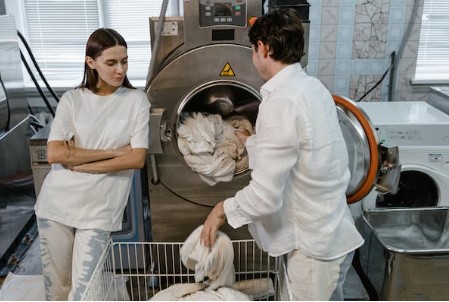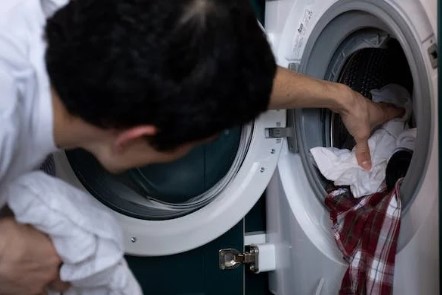We all want to stay within the confines of the law and observe all the safe building precautions when installing a washing machine’s drainage system. One question, however, that’s likely to pop up is, does washing machine drain into sewer line?
Generally, washing machines drain into the main sewer line if the home is connected to the municipality or city sewer system. However, the washer drains into an independent greywater system if the home is connected to a septic tank.
You’ll realize that the sewer line option often relates to homes in urban and suburban areas, while the greywater system is common among rural and semi-rural homes. So, judging by the setting of your home, you can tell whether your washer should drain into the sewer line or septic tank.
But in addition to the two drainage options, there are others that I’ll discuss. Moreover, we’ll examine why you shouldn’t drain your washing machine into the yard, how you can tell your washer’s drain is clogged, and how to fix it, among others.
Let’s dive in!

Does Washing Machine Drain into Sewer Line?
Washing machines whose drain system is connected to the local sewer system drain into the municipality’s main sewer line. In that case, they drain to the same place as every other drain in the house. That includes the toilet, shower, and sink drains.
Note that we are talking about urban and suburban homes; in most cases, these homes don’t have a septic tank.
After reaching the municipality’s main sewer line, the wastewater is directed to the treatment plant for separation, treatment, and recycling.
Can A Washing Machine Drain into A Septic Tank?
You probably are asking, what if my home is not part of the municipality’s main sewer network? Well, that’s likely the case if you live in a rural or semi-rural area.
In such places, homes usually have a septic tank. However, the washing machine does not drain directly into the septic tank.
These septic tanks generally have a freestanding greywater system that the washer drains into. This freestanding greywater system is primarily a below-surface dry well.
Can Washing Machine Water Drain into Yard?
Though the washer’s wastewater may not directly harm the yard, draining on the yard is not advisable. Why?
For one, the wastewater can flood your yard, and you don’t want that, and secondly, the wastewater can wash out (or erode) the foundation of your home. Moreover, it could result in hideous water pools with soapy scum around your yard.
So what should you do?
You’ll need to drain into an underground/below-surface greywater system which, as I mentioned, is separate from the septic tank. I’ll share more on the greywater system in the next section.
Where Should a Washing Machine Drain to?
Knowing where your washing machine should drain before using it is crucial. If you are in the US or Canada, you can call 811 to inquire. Your local government will then send experts to inspect your property and talk to you.
But given the lengthy process, you may want to know your available drainage options. Ideally, the drainage options depend on your home and its plumbing work.
Here are the most typical washing machine drainage options:
1. Sewer Line
As mentioned earlier, the chances are that your washing machine drains into the sewer line alongside your toilet, sinks, and shower if you are part of a local sewer system.
In most cases, this applies to urban and suburban homes. The wastewater goes to the treatment plant from the sewer line and may find itself back in your tap after treatment and recycling.
Usually, the washer drains into a standpipe that passes the wastewater into the sewer line. The standpipe should be appropriately installed to avoid premature drainage and backflows.
In the case of premature drainage, water intended for your laundry flows out ahead of time. And in the case of a backflow, drained water finds its way back into the washer and your home.
The danger is that your already-cleaned clothes soak dirty, or your home could smell of sewer.

2. Freestanding Greywater System or Under-Surface Dry Well
Homes with a septic tank have a separate system to handle greywater. This greywater system which works independently of the septic tank collects water from your washing machine through a standpipe system.
The greywater system features an underground (about 4 m or 12 feet from the foundation) dry well, where the washer’s wastewater drains.
Since the wastewater must return to the soil safely, the under-surface dry well features gravel and several other percolating materials that allow the water to seep into the ground.
And since the laundry detergent isn’t harmful to the environment, the dry well offers a safe way to return the washing machine’s wastewater to the ground. If the greywater system is well-built, you wouldn’t have to worry about water backflow and flooding on your property.
While you can drain into the greywater system, you shouldn’t drain directly into the septic tank. Doing that may result in an overflow or clogging, which you don’t want.
3. Utility or Slop Sink
Some laundry rooms have a slop or utility sink, which allows you to drain your washer temporarily. So, this option is only temporary, unlike the other two (sewer line and greywater).
That means you can also use the slop sink as a backup (or alternative drainage) in case there’s an issue with your local sewer line or septic tank.
It’s essential, however, to secure the drain hose with zip ties or tape to ensure the water drains smoothly without leakages.
While at it, ensure the drain hose is at least 5 inches above your drainage outlet. That will promote good drainage.
Note that a utility sink is a large sink often used to wash clothes and pets, primarily found in the laundry room or garage. A utility sink is connected to the main sewer line or the septic tank. That explains why it’s only a temporary solution.
4. Sump Pit
A sump pit is a large hole in the basement floor that collects water that seeps into the basement. This drainage feature connects to the sump pump, which pumps wastewater into the main city sewer line. But besides the sewer line, the sump pit can drain into the septic tank.
5. Floor Drain
The floor drain is a drainage solution on the floor of your home, which collects wastewater and passes it to the main sewer line. This system picks wastewater from every other appliance, including the washer, and you can find it in the basement, garage, or laundry room.
Why Does My Sewer Back Up When I Use the Washing Machine?
Your washing machine shouldn’t back up, especially if it’s the sewer. Such an issue is so severe that you should call a plumbing expert.
Here are the reasons sewer may back up when using the washing machine:
- Poor drainage – The chances are that your washer’s drain is clogged, thus stopping the washer from draining properly. Yes, the waste might be draining but only just slightly.
- Washer and kitchen sink sharing a drain – The washer and kitchen sink shouldn’t share a drain. If they do, the greasy water and food may clog up the drain, and that may cause a backup.
- The drain pipes are made of cast iron – The problem with cast iron is that it’s likely to rust. When it does, the rust blocks the line, which can cause a backup. You’ll mostly find cast iron pipes in old homes.
- Clogged p-trap – Sometimes, the clogging problem is not with a drain pipe but with the p-trap. Upon clogging, the p-trap is unable to catch large clogs and debris.
What Should You Do
Once you note that the sewer is backing up when using the washer, you should stop using it and call a certified washer expert.

How to Tell If Washing Machine Drain Is Clogged
You can quickly tell you have a clogged washing machine drain by watching out for these signs:
- The washing machine won’t fill with water
- The washers drain overflows
- Water spills out of the washer onto the floor
- The water makes some vibrating noise when running
People Also Ask
1. Why Does My Washing Machine Drain Smell Like Sewer?
Your washing machine drain smells like a sewer because the sewer line is clogged. And if that’s not it, it could be due to a wrong p-trap height. Ideally, the p-trap should be 6 – 18 inches off the ground. Call an expert plumber to check and fix things in both cases.
2. Does Washing Machine Drain Hose Need Elevated?
A washing machine’s drain hose must be elevated to promote good drainage and prevent backflows. The same goes for the p-trap, which should be 6- 18 inches off the ground, and the dry well, which should be 12 ft. off the ground.
3. Does Washing Machine Drain to Septic?
Washing machines don’t directly drain onto the septic tank. They, however, drain into a separate dry well or greywater system, which you’ll find in homes with septic drainage. These usually are rural and semi-rural homes.
4. Is The Washing Machine Connected to The Sewer Line?
Not all washing machines are connected to the sewer line, but only those that are part of the municipal sewer system. In such cases, all the drains, including the toilet, sink, washer, and shower, drain into the sewer system.
5. Can A Washing Machine Drain to The Outside Instead of the Septic?
It’s illegal to drain the washing machine outside instead of the septic tank. In such places, you can drain into a separate dry well, not the septic tank.
But if you are connected to the local sewer line, you can drain the washing machine there.
6. Does A Washing Machine Need Its Own Drain Line?
Typically, washing machine drains need a standpipe that connects them with the main sewer line or underground dry well (or greywater system).
But other than the standpipe, washing machines don’t require their own drain lines as the water ends up in the same place as the rest of the house, and that’s the sewer line.
In conclusion, does washing machine drain into sewer line?
As shared, washing machines drain into the sewer line if they are part of the local sewer system. If not, and you have a septic tank, empty the washer into a separate greywater system or dry well.
And if you only require a temporary drainage solution for your washer, consider a utility sink, sump pit, or floor drain.
Also Read:
